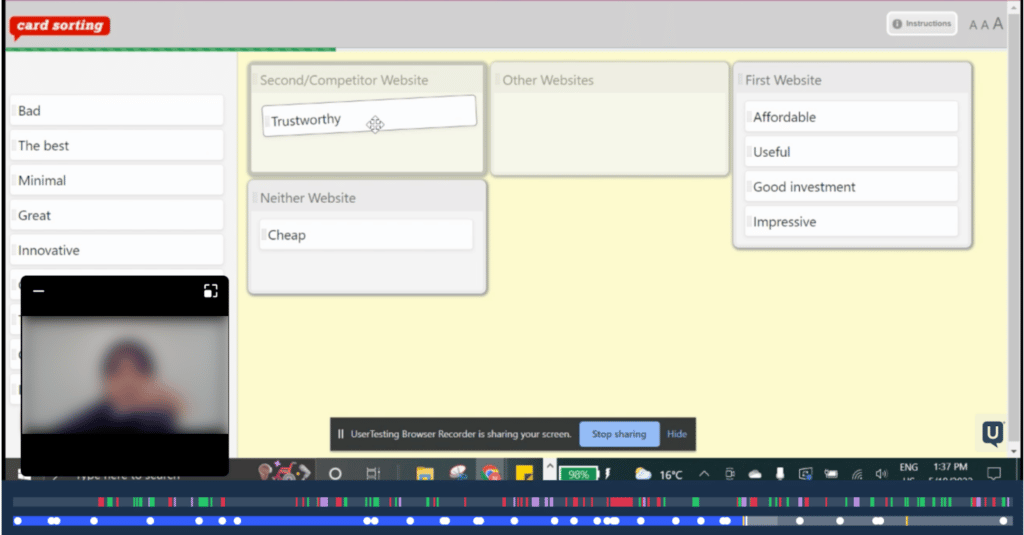Contents
Editor’s note: Lawrence Williams is a sociology professor who recently joined UserTesting. He’s pioneering the use of human insight technology in novel ways to explore issues far beyond usability.
Mental models drive much customer behavior
In order to ensure that your brand delivers excellent experiences to your customers, you need to ensure that what you deliver is aligned with what they expect. To test for this alignment, leading companies measure what psychologists call mental models: the bundles of assumptions that customers have about a brand, interface, or experience.
Testing mental models in the traditional way is extremely complex. It relies on multiple methods, each requiring several participants and skilled researchers. As a result, companies tend to overly depend on metrics like net promoter score (NPS) and customer satisfaction (CSAT) as proxies of mental models. Rather than truly fleshing out the contours of how customers think about the various facets of a brand, these metrics focus on users’ overall impressions and sentiments. You get the illusion that you understand, but really all you get is a snapshot metric and no true understanding of the emotions that drive most purchasing decisions.
Fortunately, with the advent of human insight solutions, it is now possible to flesh out customers’ mental models without all the mess. You can repurpose card sorting, a method that has typically been used to optimize the organization of a website, to quickly gauge the ways in which your target audiences perceive your brand.
What is card sorting?
If you’re not familiar with card sorting, don’t feel bad. It’s been a standard method in the UX research world for years, but it’s not well known elsewhere. In card sorting, you give users a set of terms in the form of cards, and have them either sort them into predefined categories (this is called a closed card sort), or into clusters that they then label (called an open card sort). You can also do a combination of the two (predictably called a hybrid card sort). The piles they create, and the commentary they make as they sort them, reveal the users’ underlying mental models for the topic in question.
When used in experience design, this information is used by designers to organize the information on a website. A prototype is then tested, leading to the rapid development of refined experiences that will make sense to target users. Because of the speed at which card sorts can be conducted and analyzed, this fosters an agile and collaborative development process.
But there’s a catch to this story. This method is typically used solely with a focus on information architecture (IA). IA is a fancy term for the way something is built and/or organized. For example, the IA of a website consists of its top-level menu structure, the menus that pop up out of those, the various pages and/or subdomains of the website, and so on.
Or at least that’s how it’s usually been.
How to use card sorts to understand mental models
If card sorts reveal the mental models that underlie how people categorize the information on a website, couldn’t they also reveal the mental models that shape their purchase intent? Their overall impressions of your brand? Or, well, pretty much anything? I am finding that they can. They have this capacity because, fundamentally, they ask people to think about how things fit together – something that’s easy to say in response to a question, but harder to actually demonstrate. That is exactly the gap that card sorts fill: they ask people to assemble categories of words that fit together in their mental models.
To design a card sort that gets at a wider variety of mental models, start with the end goal in mind. This means truly empathizing with your customers, and thinking through which aspects of your experiences are most important to them.
The best way to find that out is to ask them. Create a series of categories that represent different facets of your experience. To stick with the example of a website, these could be “purchase intent,” “overall impressions,” “information architecture,” etc. Then create cards that users can place into the best-fitting category. For example:
- To capture purchase intent, use cards like “makes me want to buy”, “affordable”, and/or “out of reach”.
- To capture overall impressions, use “inspiring”, “great”, and/or “the worst”
- To capture IA, use “cluttered”, “visually appealing”, and/or “clear”
You don’t need to run a series of separate tests to explore these categories. Instead, you can put all of the cards together in a single test, and ask the users to sort them. Here’s an example of how that looks in practice: You create a series of attributes (the cards) that you will ask users to attach to the websites that they’re evaluating (your site, a competitor’s site, etc).
In traditional card sorting, all you would get from the test is a statistical readout on how many people felt in a particular way. For instance, you might learn that 8 out of 10 users didn’t find your website particularly innovative. That doesn’t tell you why this is the case. So you would have to follow up with user interviews to discover the themes that this exercise unearthed.
But you can skip those followup interviews if you do the card sort through a human insight system.
Leading with empathy
Because a good human insight system captures audio feedback, facial expressions, and body language, you can experience the categorization process alongside users. Because contributors are coached to think aloud, you’ll be able to hear why a given term/sentence was connected to a given category, while also being able to gauge the user’s sense of definitiveness or hesitation. Thus, in addition to the “why” of the categorization, you’ll also understand which aspects of your experiences leave clear lasting impressions for your target audiences and which don’t.
For example, did users confidently state that one of your experiences was “inspiring,” while seeming more skittish to label it “innovative”? If being seen as innovative is important to you, then this is a signal that more work should be done to drill into why users aren’t totally convinced. Even more importantly, you may find that despite not being seen as innovative, the experience was seen as “trustworthy” and a “good investment,” signaling that perhaps innovation isn’t actually important to that user when it comes to their overall purchase intent. If this is the case, you’re learning something important about your brand perception: perhaps what you think is important to your users isn’t actually what moves the needle for them; or perhaps your target audience enjoys your services for reasons you didn’t anticipate. All of these results can inform future card sorts, each designed to continue the process of iterating your core experience with newly gleaned information about what resonates for your audiences and what doesn’t.
Competitive card sorting
You can also use card sorts to have users compare your experiences with those of your competitors. Not only does this give you much-needed competitive intel, but it also helps further ground your users in concrete examples of experiences that they can contrast to your own. It also enables them to bounce their ideas between the two experiences, really thinking through their responses and the way they’ve filled in your categories.
If you’re going this route, place the card sort in your test after you’ve had users perform a task or two on both your site/experience and a competitor’s. This will help users get a baseline understanding of both experiences, before you ask them to make a comparison.
Since users go through the card sort at the end of the testing process, you can also think of them as summaries of the broader task flow you had them embark on. You can check for inconsistencies between their card sort and previous tasks, enabling you to see if their lasting impressions differ from their initial impressions of the experiences. If they do, that isn’t necessarily a bad thing, but could offer an opportunity to strengthen the overall perception of your brand using the feedback users offered throughout (e.g., not finding you particularly “trustworthy” compared to a competitor, despite being seen as more “impressive”).
Here’s a card sort in action for comparing the mental models associated with competitive websites:

A powerful new way to get inside customers’ heads
We need to stop thinking of card sorts as only a way to organize websites. They are actually a powerful way to understand customer thinking in any situation, ranging from brand loyalty to purchase intent. By having users organize their thoughts about you into categories, and using this information both in the aggregate and individually, you can bridge the gap between you and your users, ultimately providing them with better experiences that keep them engaged, coming back, and raving about you to others.
Photo by Rostyslav Savchyn on Unsplash
The opinions expressed in this publication are those of the authors. They do not necessarily reflect the opinions or views of UserTesting or its affiliates.







